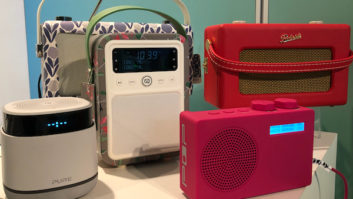
The term “enhancement” has been used a lot lately in broadcast circles. No, I’m not talking about those TV commercials promising increased manliness, but about the addition of new functionality to radio that makes it — well, OK, sexier. (So maybe there’s a connection there, but that’s not the point …)
We’re talking about things like tagging, RadioDNS, a radio electronic program guide, social networking and mobile radio applications like Radiolicious, WunderRadio and iHeartRadio. These are all items we have discussed here individually in the past; but when viewing them all together, some important common threads emerge.
Analyzing these patterns may help us better understand the general path to future success for radio, and help promote development of additional — perhaps superior — solutions along the same lines.
All Things Connected
The most obvious and fundamental property shared by those developments is their “connectedness” — they all involve some convergence of radio and the Internet.
Both radio and the Internet have extremely deep penetration (sorry, didn’t mean to go there again), yet users of each service usually require separate terminals to access them today. So it’s no wonder that there’s much interest in development of systems and devices that could leverage an intersection of these separately popular mediums into a powerful, converged überservice.
Technically speaking, achieving this is almost trivial, given the amount of processing power and connectivity we have in our homes, offices, dashboards and pockets today. The real trick is gaining traction in the marketplace, which starts with getting all the necessary players involved to synchronize their efforts.
This is harder than it looks (OK, now just stop that!). The businesses that have established themselves around each component have their respective — and sometimes opposing — priorities and revenue models. Both technical and business elements must align for any convergence to take root. Only then can the process of motivating consumers’ uptake of the service begin.
Third-party-driven
(click thumbnail)
This is how Jump2Go explains the tagging services it provides. One solution is the creation of a new entity with no legacy interests, which drives the involved incumbents toward a commonly attractive goal. A great example of this is the process called “tagging.”
Basic awareness of tagging is fairly widespread in radio, but its precise operation is less understood. Because it represents a relatively successful, early instance of radio convergence, clarity on its operation is worthwhile. Here’s how it works:
The third party driving music tagging today is a Seattle-based company called Jump2Go, founded by radio veteran (and RDS expert) Allen Hartle. The Jump2Go recipe includes the following ingredients:

- • Music-formatted radio stations with metadata-broadcasting capability (FM RDS or HD Radio datacasting)
- • Online music stores (iTunes and Zune Marketplace)
- • Music players with FM or HD Radio tuners, including metadata reception and song-marking capacity in memory
- • A backchannel method of connecting the devices to the stores (the Internet)
These items are then assembled via the following process:
- Jump2Go works with Apple and Microsoft to obtain their current music catalogs, which contain unique IDs for each song they respectively carry. Jump2Go holds these IDs in databases, updated frequently.
- As a participating station airs a given song, it sends the song title/artist data to Jump2Go in real time via a secure Internet connection. Jump2Go then sends the station back the corresponding (encrypted) Apple and Microsoft IDs in the form of a proprietary RDS ODA (Open Data Application) field, which is inserted in the station’s RDS signal, and/or a corresponding HD Radio datacast field. (Jump2Go may also return scrubbed and reformatted title and artist data in the RT+ format for RDS, or in the PSD format [ID3] for HD Radio, plus additional rich data, like album cover art, for use in online streams. Note that the music stores’ song-ID tags themselves are not carried as RT+ data but in ODA fields.)
- A listener with a tagging-enabled device (today these include Zunes running V3 or later software, iPod Nano V5 or one of several HD Radio/tagging-equipped iPod docks) listens to a participating station and tags a certain song. In addition to the song ID, the tag also includes a unique identifier for the radio station.
- The listener then connects the device to the appropriate online music store, either via syncing it through a computer, or in the case of Zune, directly via a WiFi connection. All tagged songs are then displayed on the PC or device, and the user can choose to purchase and download them from the online store.
Everybody wins
By this process, the online record stores make additional sales, and the radio stations from which the tags originated get a cut of each sale (reportedly ~5 percent) as “affiliate” members.
It’s a pretty straightforward process for all of the players. The online music stores utilize existing “Affiliate” programs to assign each station an affiliate ID that Jump2Go embeds in the Tagging ODA so the appropriate stations are given their earned commissions. Neither the music stores nor the stations have to deal with each other directly to complete these transactions, or worry about formatting/broadcasting the proper data — Jump2Go manages that for them.
Physically, the process is enabled by a small hardware device (not a PC) called the “JumpGate” that connects via USB or Ethernet to the station’s automation system, its RDS encoder (plus its HD Radio Importer and streaming Web servers, if desired), and the Internet — for secure access to Jump2Go’s data center. Stations buy these devices from Jump2Go, and pay the company a monthly service fee, for which Jump2Go provides rich metadata for the songs a station plays — including the tags that enable stations to collect new revenue via sales commissions from online music stores. (The JumpGate product also enables RT+ on RDS encoders that do not natively support that new format extension — in other words, pretty much all encoders in the field right now.)
Thus a single third-party operator enables and adds value by streamlining the system for both ends of the process, acting as an aggregation agent or “clearing house” that links the songs radio stations play with rich metadata forms — including some that provide ecommerce opportunities via tagging.
This is the just the kind of model that is required to motivate all the necessary players in the value chain. It may sound innovative, and the specifics of it certainly are, but at its heart it’s really no different than any traditional retail process, whereby a vendor markets and sells product through a series of other parties, each of which gain some benefit.
The power of converging two extremely popular but as yet largely disconnected media — radio and the Internet — will likely bring forth other examples of such “enhancements” in our future, and we’ll continue to cover them here. (Seek help immediately if you find yourself reading about them for more than four hours.) More on this — and less innuendo — next time.
Skip Pizzi is contributing editor of Radio World. Follow him on Twitter attwitter.com/skippizzi.











